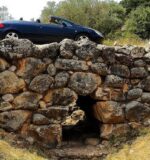The world’s oldest bridge still exists, and it’s still very much in use today – and you can find it in Arkadiko, Greece.

The world’s oldest bridge is still in use and yes, it can be visited! This ancient stone bridge is so old that it dates back to days when chariots were crossing it rather than cars and people, and it’s a steadfast landmark in Greece. Amazingly, the bridge itself is structurally sound and has survived thousands of years of use, just to be a means of modern transportation to this day.
While most bridges require constant upkeep and inspections to ensure their safety, this stone-constructed bridge is solid as a rock (no pun intended). The landmark also serves two purposes: in addition to being a usable bridge, it’s also an ancient artifact that shows the early architecture of Ancient Greece.
This is what it’s like to visit Arkadiko Bridge.
The Construction Of Arkadiko, The World’s Oldest Bridge, In Greece
Arkadiko Bridge isn’t only the oldest in Europe; it’s estimated to be one of the oldest in the world. Its construction dates back to the Mycenean Era, and its architecture features classic details that can be seen throughout other Mycenean settlements. It also goes by the name of the Kazarma Bridge but no matter what it’s called, its ancient age is what draws visitors to cross over its stone archway.
While the bridge itself is able to hold cars and has been known to handle vehicle traffic, it’s only endorsed now for use by pedestrians. The bridge serves as a go-between over the gap twixt Tiryns and Epidauros and is well-visited by locals and visitors alike. During the Mycenean Era, the bridge was used to go between Epidauros and Mycenae, being used first as a military road before it was used as a general public roadway.
Interestingly enough, the intended purpose of the bridge lies in its unique construction. Its measurements come out to 72 feet long by 18 feet wide, and 13 feet tall. These would have been the perfect specifications to allow chariots to pass through with ease; thus, it was determined that this is exactly what the purpose of the bridge was. The bridge’s height was also attributed to chariot travel, as they would have been horse-drawn chariots, transporting goods and serving as a transport for Greek soldiers.
How Is The Bridge Still Standing?
The first thing many people wonder when seeing the bridge for the first time is how it could possibly still be standing, let alone be safe for crossing. The answer lies in how it was built, which is really quite brilliant, keeping in theme with many architectural monuments that came from the ancient Greeks. Using a method called Cyclopean masonry, the bridge was built by layering solid blocks of limestone atop one another. Using no adhesive, the blocks slide together to create somewhat of a locking fit, with some stones showing signs of chiseling in order to fit into place. The result is a tight-fitting wall with little space left to spare, resulting in the blocks settling and leaning against one enough for support.
- Built: Between 1300 – 1190 BC
Visiting Arkadiko Bridge In Akradiko, Greece
Visiting the bridge is both a historic and novel experience since to see it in person is to take a look into the Bronze Age. The incredible, yet simple, construction of this bridge is something that doesn’t often survive the test of time, but the Arkadiko Bridge has. Its large limestone blocks often make one wonder how it is that an early civilization could have completed such a task without modern tools, and its stability makes one realize the intelligence behind such an act.
Although the bridge itself might seem crudely constructed with smaller rocks pressed in between larger boulders, this was all done intentionally. And, clearly, it worked – since the bridge is still operational more than 3,000 years later! More revealing details include the small curbs along the bridge that were intended to guide horse-drawn chariots as they made their way to the other side. It’s also easy to see how each of these things served as an inspiration for future bridges, with some methods even incorporated into the construction of stone bridges to this day. The bridge is able to be viewed from the top and the bottom, although visitors should take care to walk down to the ravine over which the bridge stands.
- Where To Find It: Located at the 15th kilometer along the Nauplion-Epidaurus highway
- Note: Visitors to the bridge should take care to park in such a way that it doesn’t block traffic on the highway.
For those visiting Arkadiko, Greece, or anywhere in the surrounding area, this bridge is a must – and not just for history buffs!
Via: thetravel.com








 Photographer Finds Locations Of 1960s Postcards To See How They Look Today, And The Difference Is Unbelievable
Photographer Finds Locations Of 1960s Postcards To See How They Look Today, And The Difference Is Unbelievable  Hij zet 3 IKEA kastjes tegen elkaar aan en maakt dit voor zijn vrouw…Wat een gaaf resultaat!!
Hij zet 3 IKEA kastjes tegen elkaar aan en maakt dit voor zijn vrouw…Wat een gaaf resultaat!!  Scientists Discover 512-Year-Old Shark, Which Would Be The Oldest Living Vertebrate On The Planet
Scientists Discover 512-Year-Old Shark, Which Would Be The Oldest Living Vertebrate On The Planet  Hus til salg er kun 22 kvadratmeter – men vent til du ser det indvendigt
Hus til salg er kun 22 kvadratmeter – men vent til du ser det indvendigt  Superknepet – så blir snuskiga ugnsformen som ny igen!
Superknepet – så blir snuskiga ugnsformen som ny igen!  Meteorite That Recently Fell in Somalia Turns Out to Contain Two Minerals Never Before Seen on Earth
Meteorite That Recently Fell in Somalia Turns Out to Contain Two Minerals Never Before Seen on Earth  Nearly Frozen Waves Captured On Camera By Nantucket Photographer
Nearly Frozen Waves Captured On Camera By Nantucket Photographer  It’s Official: Astronomers Have Discovered another Earth
It’s Official: Astronomers Have Discovered another Earth 
bf4e5g
gjiquy
og43pt